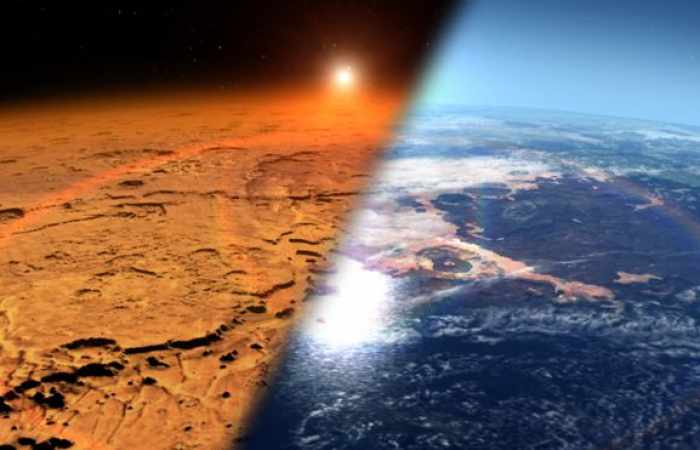The composition would have been very different, however.
The early Martian air, most likely, had a significant volume of carbon dioxide.
That would have been important for the climate, as the greenhouse gas might have been able to warm conditions sufficiently to support nascent lifeforms.
"We're in the process of tallying up what the total amount removed was, but I'm going to guess right now that the amount of atmosphere that was present was about as thick as the Earth's atmosphere - about one or two bars of gas," said Bruce Jakosky from the University of Colorado in Boulder, US.
"The bulk of that - maybe 80-90% - has been lost to space," he told the BBC.
Prof Jakosky is the principal investigator on the US space agency's (Nasa) Mars Atmosphere and Volatile Evolution Mission (Maven) satellite.
Since arriving at the Red Planet in 2014, Maven has been studying the composition and behaviour of the upper atmosphere.
And for a new paper just published in Science magazine, the satellite has looked in detail at the properties of the noble gas argon.
Atoms of this gas exist only in small numbers - just a few parts per million.
But argon is very instructive. It is inert: it will not react with other components of the atmosphere or indeed surface materials such as rocks.
This means the only way it can be lost from Mars' air is by being dragged away into space by the abrasive action of the solar wind - the billowing stream of charged particles constantly flowing from the Sun.
Just how much argon has been removed over the course of 4.5 billion years of Mars history is divined from the ratio of heavy to light versions, or isotopes, of the atom. The light version (argon-36) escapes more easily than the heavy version (argon-38), which leaves the gas remaining behind enriched in the more massive isotope.
Prof Jakosky and his team used the relative abundance of the two argons - measured by Maven in the upper atmosphere and by Nasa's Curiosity robot at the surface - to estimate the fraction of gas that must have disappeared over time.
"What we've seen from the argon measurements is that about two-thirds of the argon that was ever in the atmosphere has been lost to space. That means that most of the gas in the atmosphere has been lost," the PI explained on the Science In Action programme of the BBC World Service.
"Argon isn't an important gas for understanding the climate, but it does tell us about the carbon dioxide, because the same processes that can remove argon can also remove carbon dioxide. So, we're able to determine that the bulk of the CO2 in the atmosphere has also been lost to space through time."
The findings are important because they inform our understanding of how an ancient Mars was able to retain liquid water at its surface - a scenario that would have been conducive to life.
Today, the thin air produces a pressure that cannot support any exposed water; it would rapidly boil away. So a much thicker shroud of gas in the past is really essential from the point of view of habitability.
Climate conundrum
That liquid water once stood on Mars' surface or flowed freely at times seems obvious. Pictures of the planet reveal the traces of countless river beds, flood plains and deltas. And the Curiosity rover has found definitive evidence of persistent lakes at its operation site in Gale Crater.
However, climate models, based on the limited evidence to date of what the atmosphere was like, have struggled to simulate a Mars on which conditions were warm enough to allow lots of liquid water. Much of it would have been locked up in ice, they suggest.
"There's always been this tension between the geologists who see these rivers and lakes, and the modellers who say they can't get the atmospheric conditions to tie in," commented Dr Matt Balme, a planetary scientist at the UK Open University.
"The Maven results are great because what's been stopping the models being useful is that we don't know what the CO2 inventory really was.
"Knowing now that the atmosphere had a pressure of one to two bars will be very helpful in that respect, and there is sure now to be another round of climate modelling to see if we can't better address some of these issues."
More about: #science
















































